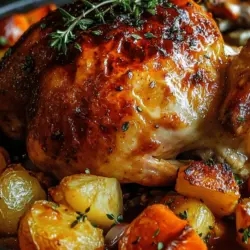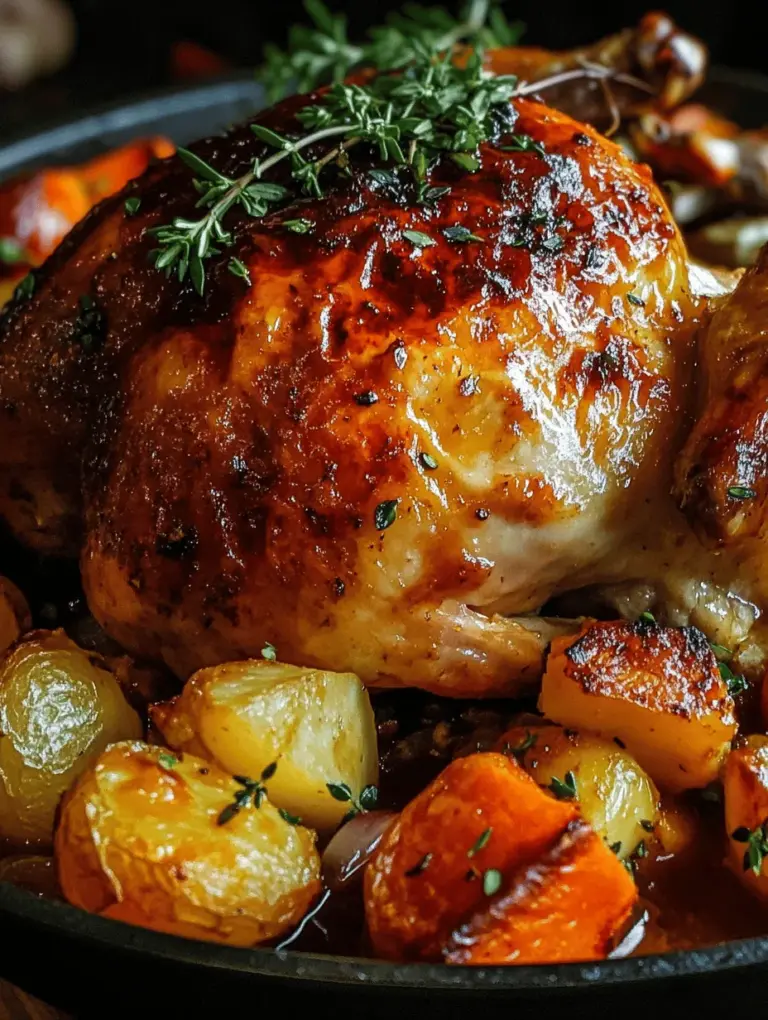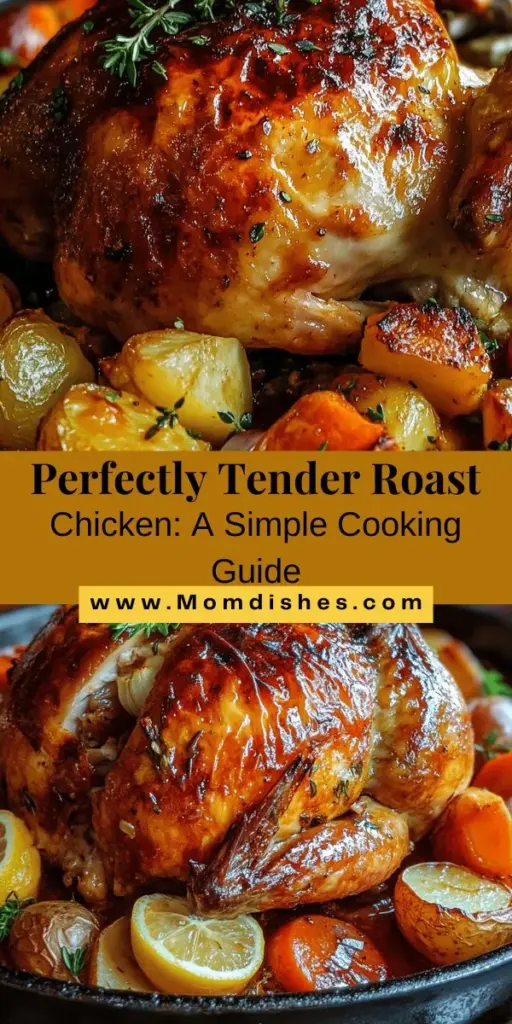Introduction to Tender and Juicy Roast Chicken
When it comes to comfort food, few dishes are as universally beloved as a perfectly roast chicken. Tender and juicy roast chicken not only serves as a centerpiece for any family dinner but also evokes a sense of warmth and nostalgia that can transform an ordinary meal into a memorable experience. From Sunday dinners to holiday feasts, the appeal of a golden-brown, succulent chicken is hard to resist. This dish is not just about taste; it represents the heart of home cooking, where flavors meld together to create something truly special.
One of the key reasons for the popularity of roast chicken lies in its simplicity. With just a handful of ingredients and a bit of technique, you can create a dish that is both impressive and deeply satisfying. The allure of roast chicken stems from its ability to be incredibly versatile yet simple, allowing for various seasonings and accompaniments to shine through. Whether you’re serving it with a side of roasted vegetables, a fresh salad, or simply on its own, this dish never fails to deliver on both flavor and presentation.
In this article, we will delve into the essential elements that make up a tender and juicy roast chicken. We will explore the importance of ingredient quality, preparation techniques, and seasoning methods that enhance the final product. As we embark on this culinary journey together, you will learn how to achieve that perfect roast chicken that is tender, flavorful, and sure to impress your family and friends.
Understanding the Ingredients
To create a delicious roast chicken, understanding the ingredients that contribute to its flavor and texture is crucial. Each component plays a significant role in the final outcome, making it essential to choose wisely.
Whole Chicken: Choosing the Right Size and Quality
The foundation of any great roast chicken is, of course, the bird itself. When selecting a whole chicken, aim for a size that fits your needs—typically, a 4 to 5-pound chicken is ideal for a family meal. Look for chickens that are labeled as organic or free-range, as these often have better flavor and texture compared to conventionally raised birds. Freshness is also paramount; if possible, buy from a local butcher or farmer’s market to ensure you’re getting the best quality.
Fresh Herbs: Rosemary and Thyme for Aromatic Flavor
Fresh herbs are a game-changer when it comes to flavoring your roast chicken. Rosemary and thyme are two classic choices that impart a wonderful aromatic quality. Rosemary offers a slightly pine-like flavor that pairs beautifully with chicken, while thyme contributes a warm, earthy note. Use these herbs generously, whether you’re adding them to the seasoning mix or tucking them under the skin for maximum flavor infusion.
Garlic and Lemon: Enhancing Flavor Profiles
Garlic and lemon serve two distinct yet complementary purposes in this roast chicken recipe. Garlic adds depth and a savory kick, while lemon brings brightness and acidity that balances the richness of the meat. You can use fresh garlic cloves, which can be smashed and scattered inside the cavity, or roasted whole alongside the chicken. For the lemon, simply cut it in half and place it inside the cavity as well; this will allow the juices to steam and flavor the chicken as it cooks.
Seasonings: Importance of Kosher Salt, Pepper, Paprika, Garlic Powder, and Onion Powder
Seasoning is crucial for elevating the flavor of your roast chicken. A simple blend of kosher salt and pepper serves as the foundation; kosher salt, in particular, is excellent for drawing out moisture and enhancing flavor. Paprika adds a beautiful color and mild sweetness, while garlic powder and onion powder contribute to a well-rounded taste. The key is to season the chicken generously, ensuring that every bite is bursting with flavor.
Optional Vegetables: Benefits of Roasting Alongside the Chicken
Roasting vegetables alongside your chicken is not only practical but also enhances the overall dish. Common choices include carrots, potatoes, and onions, which caramelize beautifully as they absorb the chicken’s juices. These vegetables not only serve as a delicious side but also create a more visually appealing presentation. Plus, they can soak up the aromatic flavors from the herbs and seasonings, making for a fantastic accompaniment.
Preparation Steps for Perfect Roast Chicken
Now that we’ve covered the essential ingredients, let’s dive into the preparation steps that will help you achieve that tender and juicy roast chicken.
Preheating the Oven
The first step in your roast chicken journey is preheating the oven. Setting the right temperature is crucial for achieving crispy skin and thoroughly cooked meat. Preheat your oven to 425°F (220°C)—this high temperature will help render the fat from the skin, resulting in a beautifully crispy exterior.
Importance of Temperature for Crispy Skin
Crispy skin is one of the hallmarks of a perfectly roasted chicken. To achieve this, it’s important to maintain a consistent oven temperature throughout the cooking process. Starting at a higher temperature allows the skin to crisp up quickly, while the meat inside remains juicy. Avoid opening the oven door too frequently during cooking, as this can cause temperature fluctuations that hinder the roasting process.
Recommended Oven Settings for Optimal Roasting
For optimal roasting, consider using a convection setting if your oven has one. This feature circulates hot air around the chicken, promoting even cooking and browning. If your oven doesn’t have a convection option, simply use the standard bake setting. Additionally, placing the chicken on a roasting rack will allow the heat to circulate around the bird, ensuring even cooking and preventing it from sitting in its own juices.
Preparing the Chicken
Preparing the chicken is a vital step that can significantly impact the final result. Start by removing the chicken from its packaging and patting it dry with paper towels. This step is crucial; moisture on the skin can prevent it from crisping up properly.
Importance of Drying the Chicken for Crispiness
Drying the chicken helps to ensure that the skin crisps up beautifully during roasting. After patting it dry, allow the chicken to sit uncovered in the refrigerator for at least an hour or even overnight if time allows. This process helps to further dry out the skin, leading to an even crispier finish.
Techniques for Effective Seasoning Application
Once the chicken is dry, it’s time to season. Generously sprinkle kosher salt all over the chicken, making sure to get into the cavity and under the skin. The seasoning should be ample—don’t be shy! After salting, add your other seasonings, like pepper, paprika, garlic powder, and onion powder, ensuring an even distribution.
Seasoning Techniques for Maximum Flavor
Now that your chicken is prepped and seasoned, let’s dive deeper into the techniques that will maximize flavor.
Creating the Seasoning Mix
To create a well-balanced seasoning mix, combine kosher salt, black pepper, paprika, garlic powder, and onion powder in a small bowl. Adjust the quantities to your preference, but a good starting point is two teaspoons of salt, one teaspoon of pepper, one teaspoon of paprika, and half a teaspoon each of garlic and onion powder. This mixture will ensure a flavorful crust that permeates the meat.
Breakdown of Each Ingredient and Its Flavor Contribution
– Kosher Salt: Enhances flavor and helps tenderize the meat.
– Black Pepper: Adds heat and complexity.
– Paprika: Provides color and a mild sweetness.
– Garlic Powder: Infuses a rich, savory flavor.
– Onion Powder: Offers sweetness and depth.
Tips on Applying the Seasoning Under the Skin for Enhanced Taste
For an extra punch of flavor, consider applying some of your seasoning mix under the skin. Gently separate the skin from the meat using your fingers, being careful not to tear it. Rub a portion of the seasoning mix directly onto the meat, ensuring even coverage. This technique allows the flavors to penetrate deeper, resulting in a more flavorful roast chicken.
Stuffing the Chicken
Stuffing the chicken with aromatics is a great way to infuse additional flavor during cooking. As mentioned earlier, placing halved lemons, garlic cloves, and fresh herbs inside the cavity will elevate the dish to new heights.
Benefits of Using Aromatics in the Cavity
When you roast the chicken, the heat will cause the aromatics to release their essential oils, which will then flavor the meat from the inside out. This technique not only enhances flavor but also helps to keep the chicken moist throughout the cooking process.
How Aromatics Infuse Flavor During Cooking
As the chicken cooks, the aromatics will steam and mingle with the juices, creating a flavorful broth that can be used for gravy or served alongside the chicken. This broth becomes a deliciously savory addition to your meal, enhancing every bite.
Roasting Process: Achieving the Ideal Texture
With your chicken properly seasoned and stuffed, it’s time to get it into the oven for roasting.
Arranging for Roasting
To arrange for roasting, place your seasoned chicken breast-side up on a roasting rack set inside a baking dish or roasting pan. This allows air to circulate around the chicken, ensuring even cooking. If you’re roasting vegetables alongside the chicken, scatter them in the bottom of the pan, surrounding the chicken. As the chicken roasts, the drippings will flavor the vegetables, creating a delightful accompaniment to your meal.
By following these preparation steps and understanding the role of each ingredient, you are well on your way to creating a tender and juicy roast chicken that will impress everyone at your table. In the next section, we will explore the roasting process in detail, providing you with the tips and techniques needed to achieve the ideal texture and flavor. Stay tuned for more insights into perfecting your roast chicken!
{{image_1}}
Importance of Vegetables as a Flavor Base
Using vegetables as a flavor base is crucial for enhancing the overall taste of your roast chicken. When roasting, vegetables such as onions, carrots, celery, and garlic not only add their unique flavors to the chicken but also help to create a delicious, aromatic broth that can be used for gravy or as a side dish. The moisture released from the vegetables during roasting infuses the chicken with extra juiciness and flavor, making each bite more satisfying.
To achieve the best results, consider using a mix of root vegetables and aromatic herbs. Root vegetables, such as potatoes and sweet potatoes, will caramelize beautifully, while herbs like thyme, rosemary, and sage will impart a fragrant aroma that complements the chicken perfectly. Layering these vegetables beneath the chicken will allow them to absorb the drippings, resulting in a flavorful and tender base that enhances the entire dish.
How to Layer Chicken and Vegetables for Even Cooking
Layering chicken and vegetables correctly is essential for ensuring even cooking. Start by placing the vegetables in a single layer in the roasting pan, creating a bed for the chicken to rest upon. This not only allows for better air circulation around the chicken but also prevents it from sitting in its fat, which can lead to sogginess.
When preparing the chicken, pat it dry with paper towels to remove excess moisture, which helps in achieving a crispy skin. Season the chicken generously with salt and pepper, and if desired, add other spices or herbs. Place the chicken breast-side up on top of the vegetable layer. This positioning allows the juices to flow down, flavoring the vegetables while keeping the chicken moist. For added flavor, consider stuffing the cavity of the chicken with lemon halves, garlic cloves, or fresh herbs.
Roasting Time and Temperature
The key to perfectly roasted chicken is understanding the correct roasting time and temperature. For a standard roast chicken, preheat your oven to 425°F (220°C). This high temperature will help achieve a crispy skin while keeping the meat juicy.
Guidelines for Cooking Time Based on Chicken Weight
A general rule of thumb for roasting chicken is to cook it for about 20 minutes per pound. For example:
– A 3-pound chicken will take approximately 60-75 minutes.
– A 4-pound chicken will take about 80-90 minutes.
– A 5-pound chicken should roast for around 90-120 minutes.
However, these times can vary based on your oven, so it’s crucial to monitor the chicken closely.
Importance of Using a Meat Thermometer to Check Doneness
Using a meat thermometer is the most reliable way to determine if your roast chicken is cooked to perfection. Insert the thermometer into the thickest part of the thigh without touching the bone. The internal temperature should reach 165°F (75°C) for safe consumption. This ensures that harmful bacteria are eliminated while retaining the juiciness of the meat.
Basting for Moisture
Basting your chicken during the roasting process is essential for keeping it moist and flavorful. Basting involves spooning the pan juices over the chicken periodically, helping to keep the skin crispy while adding moisture to the meat.
The Role of Basting in Keeping the Chicken Juicy
Basting not only prevents the chicken from drying out but also enhances its flavor. The fat, combined with the aromatics from the vegetables, infuses the chicken with rich flavors.
How Often to Baste and Techniques for Effective Basting
Aim to baste the chicken every 20-30 minutes during the roasting time. You can use a baster, a large spoon, or even a ladle to scoop up the pan juices and drizzle them over the chicken. For an added layer of flavor, consider adding a splash of white wine or chicken broth to the pan halfway through the cooking process.
Resting the Chicken: Why It Matters
Once your roast chicken is cooked to perfection, it’s tempting to dive right in. However, resting the chicken is a crucial step you should never skip.
The Science Behind Resting Meat
Resting allows the juices inside the chicken to redistribute. When meat cooks, the juices move toward the surface. If you cut into the chicken immediately after roasting, the juices will run out, resulting in a dry chicken.
How Resting Impacts Juiciness and Texture
By resting the chicken, you allow the juices to settle, making each slice moist and flavorful. This also improves the overall texture of the meat, ensuring that it remains tender.
Recommended Resting Time for Roast Chicken
Let your roast chicken rest for at least 15-20 minutes before carving. Cover it loosely with aluminum foil to keep it warm while it rests.
Serving Suggestions for Roast Chicken
Carving the Chicken
Carving the chicken correctly not only ensures elegant presentation but also helps to serve portions evenly.
Step-by-Step Guide on How to Carve for Presentation
1. Remove the Legs: Start by cutting through the skin between the leg and the body. Bend the leg outward to expose the joint, and cut through until you can remove the leg completely. Repeat with the other leg.
2. Detach the Thighs: For each leg, separate the thigh from the drumstick by cutting through the joint.
3. Carve the Breast: Use a sharp knife to slice down along one side of the breastbone, creating even slices. Repeat on the other side.
4. Serve: Arrange the carved pieces on a serving platter, interspersed with the roasted vegetables for a beautiful presentation.
Tips on Serving Portions
When serving roast chicken, consider portion sizes based on the guests. Typically, one leg and one breast per person is a generous serving. Adjust according to your guests’ appetites.
Pairing with Roasted Vegetables
Roasted vegetables make a perfect accompaniment to roast chicken. They not only absorb the delicious juices from the chicken but also add color and nutrition to the meal.
Suggestions for Seasonal Vegetables to Roast
– Root Vegetables: Carrots, parsnips, and beets are excellent choices during fall and winter.
– Green Vegetables: Asparagus, Brussels sprouts, and zucchini are delightful in spring and summer.
Flavor Combinations that Complement Roast Chicken
Consider pairing your roast chicken with herbs and spices that enhance the roasted flavors. Rosemary, thyme, and garlic are classic choices, but don’t hesitate to experiment with seasonal herbs or spices such as lemon zest or smoked paprika.
Nutritional Information and Benefits
Roast chicken is not just delicious but also packed with nutritional benefits.
Overview of Nutritional Benefits of Roast Chicken
Chicken is an excellent source of lean protein, making it ideal for those looking to maintain a healthy diet. A serving of roasted chicken provides essential vitamins and minerals, including:
– Protein: Vital for muscle repair and growth.
– B Vitamins: Important for energy production and metabolism.
– Selenium: An antioxidant that supports immune function.
Protein Content and Other Health Benefits
A 3.5-ounce (100-gram) serving of roasted chicken breast contains approximately 31 grams of protein, making it a satisfying option for meals. Additionally, it is lower in fat than many other meats, especially if you remove the skin.
Potential Dietary Considerations for Various Audiences
While roast chicken is generally suitable for most diets, it’s essential to consider dietary restrictions. For those watching their calorie intake, opting for skinless chicken can reduce fat content. Additionally, adjusting serving sizes can help meet dietary goals.
Conclusion: The Joy of a Homemade Roast Chicken
Preparing a homemade roast chicken is a rewarding experience that brings joy to both the cook and those who share the meal. By following the key steps outlined—layering vegetables, precise cooking times, and ensuring the chicken rests—you can create a dish that is not only delicious but also a centerpiece for any occasion.
The satisfaction of serving a perfectly roasted chicken, with its golden skin and tender meat, is unmatched. Whether you choose to stick to the classic flavors or experiment with new seasonings and sides, the joy of creating and sharing a homemade roast chicken is a culinary experience worth savoring. So gather your ingredients and get ready to impress your family and friends with a meal that celebrates both flavor and love.


